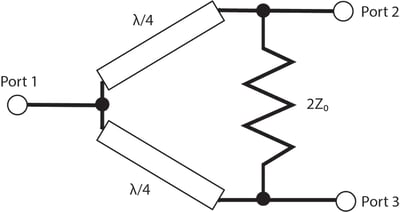The Wilkinson Power Divider, designed by Ernest Wilkinson in the 1960s, uses quarter wave transformers to split an input signal into two equal phase output signals. Since the design is reciprocal, Wilkinson Power Dividers can also be used as a power combiner. With this flexibility, they are widely used in many RF and microwave communication systems, including those with multiple channels or complex feed networks.

Figure 1: An example of a Wilkinson Power Divider that uses a single path for transmitting and receiving.
The development process and materials used to create Wilkinson Power Dividers play a crucial role in the overall device performance. Wilkinson Power Dividers have excess insertion loss incurred by the conductors and dielectric materials used to create the device itself. This relationship combined with other build processes and the system integration plan can either maximize or detract from the intended performance of the component and system. Table 1 summarizes how the performance of a Wilkinson Power Divider and its integration contribute to system performance.
|
Parameter |
Ideal Values |
Impact |
|
Return Loss |
Higher value preferred |
Directly affects the amount of power that will be transmitted or received by a beam former
|
|
Isolation |
Higher value preferred |
Directly affects the amount of isolation between signal paths in an array
|
|
Amplitude Balance |
Approaching 0 db difference |
Affects the amplitude performance and EIRP of a beamformer; aim for equal power split for each branch and across the whole bandwidth
|
|
Phase Balance |
Approaching 0° difference |
Promotes maximum power transfer and ensures intended phase length for all branches across the whole network. A large enough phase imbalance will deteriorate EIRP and potentially change the radiation pattern of a beamformer.
|
Table 1. Shows how various parameters in Wilkinson Power Dividers are impacted.
The Advantages of Knowles Precision Devices Power Dividers
Additionally, in many circumstances, the approach to building Wilkinson Power Dividers can create or remove design roadblocks for implementation. Knowles Precision Devices understands what it takes to optimize both the design and the development process of these power dividers.
Knowles Precision Devices DLI brand Wilkinson Power Divider technology offers several advantages including the following:
- Innovative low-loss, high-permittivity dielectric materials to reduce size and provide temperature stability for improved output power and DC power savings
- High K ceramics that offer a footprint that is up to three times smaller than a power divider using a PCB design
- Small form factor surface mount devices rather than PCB integrated designs to reduce the overall board complexity and cost while promoting compact integration
Additionally, DLI technology inherently provides low excess insertion loss with good, repeatable return loss, and amplitude and phase balance.
Download our full Wilkinson Power Dividers and Feed Networks white paper to learn more. 

